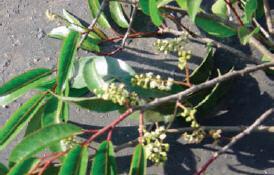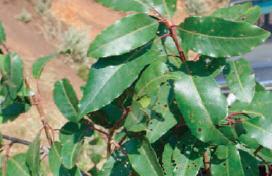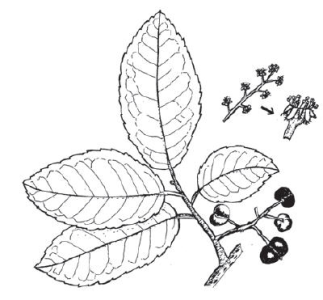Geographical Distribution of Prunus africana in Africa. Source ICRAF. Updated on 26th March 2019
Introduction
Geographical distribution:
Prunus africana is native to the montane tropical forests of Sub-Saharan Africa and Madagascar. It occurs inwild in forests from 22 countries, majority in the Eastern and Southern Africa region such as Ethiopia, Uganda, Kenya, Tanzania, Zambia, Malawi, Mozambique, South Africa, but also Cameroon, Nigeria, Sao Tome, Angola etc.
A valuable timber and medicinal tree has more recently come under heavy pressure for wild harvest for timber and bark extraction, as there is a fast growing market for the bark. It has been added to Appendix II of CITES list of endangered species, for regulation of trade from wild harvest. Kenya has the largest planted area (628 ha planted by year 2000), but the tree is increasingly becoming a popular agroforestry tree and coppices (it can be cut back and produces shoots from stools or roots) well when young. Leaves and twigs contain the same medicinal properties as the bark; so can be harvested sustainably while coppicing the tree in agroforestry systems.
The timber is hard and durable and is used in Africa for the manufacture of various household products such as axes, hoes and furniture.
Biophysical Limits:
Prunus works well as shade tree for coffee plants and other crops. It grows best in tropical highlands from 1000 to 2500 m above sea level with rainfall between 500 to 2000 mm/year and fertile loam soils.
Propagation and Tree Management:
Description:
 |
| Prunus africana |
| © A. Bekele-Tesemma, World Agroforestry Centre |
An evergreen tree to 40 m. In forests, the high foliage is open, the branches often pendulous, but in grassland the tree is more rounded and compact.
Bark:Rough, dark, scaling irregularly, branches corky, branchlets dotted with breathing pores.
Leaves: Leathery, glossy dark green above, oval to 10 cm, margin with shallow rounded teeth, leaf stalk typically pink, to 2 cm. Crushed leaves have a bitter almond smell.
Flowers: Sprays on stalks about 8 cm long, very small, fragrant, green-white.
Fruit: Rounded about 1 cm, dark red, often bilobed, containing one seed and topped by a persistant style.
Propagation and Tree Management
Products:
- Apiculture: Flowers have sufficient nectar and pollen for good bee forage.
- Fuel: P. africana produces high-quality firewood and charcoal.
- Timber: The wood is heavy, hard, durable, straight grained and strong. Red-brown, planes well, takes a high polish, but splits and twists; it is used for heavy construction work, furniture, flooring, turnery, mouldings, poles and mortars.
- Poison: Bark, bruised leaves and fruits smell strongly of bitter almonds. They are reputed to be poisonous and are used in witchcraft.
- Medicine: Liquid extracts from P. africana bark are used in the treatment of benign prostatic hyperplasia and prostate gland hypertrophy. Leaves are used as an inhalant for fever or are drunk as an infusion to improve appetite. Water is added to pounded bark, and the red liquid is used as a remedy for stomach-ache; bark extract may be used as a purgative for cattle.
- Firewood, charcoal, timber (construction), furniture, poles, utensils (mortars), carvings (earrings), medicine (bark, leaves), bee forage, shade, ornamental, mulch, green manure, windbreak, vet medicine.
Services:
- Erosion control: Trees can be grown along contour ridges and terraces.
- Shade or shelter: P. africana provides useful shade and acts as a windbreak.
- Soil improver: Leaves can be used as mulch and green manure.
- Ornamental: It makes an attractive garden shade tree.
Uses:
Firewood, charcoal, timber (construction), poles, utensils (mortars), medicine (bark, leaf ), bee forage, shade, mulch, windbreak.
Propagation:
Seedlings, wildings
There is evidence that seeds and seedlings survive best in soil with relatively high humus content. Nursery soils should contain either peat or decomposed sawdust. Seeds generally germinate 50 to 90 days after planting. Up to 50 seedlings/m² in the nursery can do well - with higher density the survival rate diminishes. Young seedlings need about 40% shade.
It is fairly slow growing and when young prunes and coppices well. The tree occurs in Plantations, mixed farming systems and enrichment planting systems. Wildings are used for large scale planting as seeds are dispersed by birds
Seed:
3400 - 6000 seed per kg; germination 60 - 80%
Treatment:
The fleshy parts should be removed from the seed.
Storage:
Seed does not store well therefore fresh seed should be used.

Prunus africana
© A. Bekele-Tesemma, World Agroforestry Centre
Management and Remarks
Husbandry
Plant young seedlings on contours and borders. Prepare two- feet deep planting holes. Fill it with back soil mixed with compost and leaf matter. Water once a week for the first year. Use a filled and upended bottle or other water conserving system.
Harvesting
Do not harvest bark till the tree is at least 30 cm in diameter at breast height. From trees 30 to 50 cm diameter two bark panels of not more than 15 to 20 cm wide can be harvested from each side of the tree from about one meter above ground level up to the first branch. After 4 to 5 years two more panels can be harvested on the other sides of the tree. If bark is over harvested the tree dies. However leaves contain the same medicinal properties as the bark, so these can be used in local medicine. From younger trees only the leaves and twigs can be pruned or coppiced.
Market
At least four European companies are actively buying bark of Prunus Africana. In 2000 the bark trade amounted to US$ 150 million/year or 3500 tonnes of this commodity. It was estimated that this demand would triple or quadruple to 7 to 11000 tons/year in export and about 500 tonnes/year for use in Africa the next few years.
Remarks:
Wildlings are commonly used for large-scale planting. Seeds are dispersed by birds. The heartwood darkens to a dense red. The tree bark is an important source of raw material for the pharmaceutical industry.
Pests and Diseases:
 |
|
Prunus africana © A. Bekele-Tesemma, World Agroforestry Centre |
Pests and Diseases
These are mainly coleopterous borers causing wood degradation, but there can be pathogenic fungi affecting nurseries.
Information Source Links
- Bekele-Tesemma, B. (2007). Useful trees and shrubs for Ethiopia. World Agroforestry Centre, Nairobi, Kenya. ISBN 92-9059-2125
www.worldagroforestry.org - ICRAF, Prunus africana www.worldagroforestry.org
- Maundu, P. and Tengnäs, B. (2005). Useful trees and shrubs for Kenya. World Agroforestry Centre. ISBN: 9966-896-70-8
www.worldagroforestry.org - Hall, J. B., O'Brian, E.M. and Sinclair, F.L. (2000). Prunus Africana - A Monograph. School of Agriculture ans Forest Sciences, University of Wales, Bangor. U.K. (ICRAF)
- Prunus Africana. en.wikipedia.org
